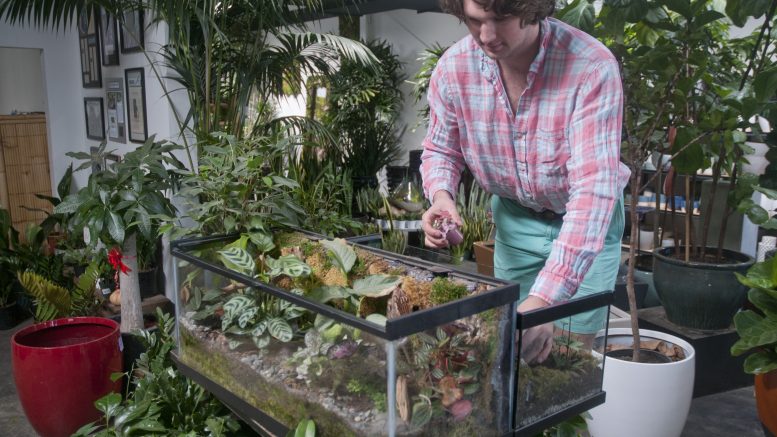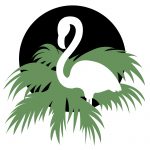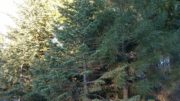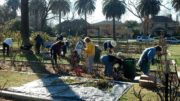Create a perfect habitat for reptiles, frogs and plants; Exotic Plants hosts two events
By Debbie Arrington
Consider this an indoor jungle that’s more than a home for plants. Critters like it, too.
Vivariums take terrarium gardening to the next level. They simulate the habitat of reptiles or other animals, usually encased by glass, Plexiglas or clear acrylic. It’s sort of like an aquarium for snakes, lizards, turtles, toads or frogs, surrounded by plants instead of water.
“Snakes are meat eaters, not plant eaters; they’re not going to nibble (on the plants),” explains Exotic Plants store manager Maxon Fackert, who has his own vivarium. “So your plant choice is a lot wider.”
Exotic Plants will host two vivarium events: A free vivarium basics class March 11 and a build-your-own vivarium workshop March 26. The store also sells ready-made vivariums packed with plants (no animals included). (For details, cost or reservations, contact the store at 916-922-4769.)
“At our free class, you’ll learn how to make your own vivarium – soil, plants, etc.,” says Fackert, who will teach both events. “It will be good for any reptile or just as a terrarium. The build-your-own workshop will include the tank, soil and plants; you’ll actually make one.”
Vivariums are particularly popular with reptile owners. A moisture-loving pet snake may be happier in its own tropical habitat. A vivarium is certainly more fun to look at than a plain tank or enclosure.
A large vivarium greets visitors to Exotic Plants’ store on Fulton Avenue in Sacramento. Filled with lush greenery, the store’s vivarium is home to a large albino boa who is easy to spot in his private jungle.
At home, Fackert keeps frogs in his vivarium. A heat mat under the tank keeps the atmosphere inside the vivarium warm and jungle-like for the little amphibians; frogs must have high humidity to keep their skin moist.
Putting together a vivarium is similar to creating a terrarium. What’s the difference? Terrariums are designed to raise plants; vivariums focus on the animals and their habitat.
Like a terrarium, a vivarium has its own (almost) enclosed ecosystem with just about everything inside to support its animal and plant life (except the animal’s food source).
The layers at the base of the vivarium act as water filters as the plants inside this mini-environment filter the air.
Fackert suggests starting with a 10-gallon tank such as a typical aquarium. The bottom and sides must be watertight.
At the bottom, he puts down a layer of LECA, lightweight expanded clay aggregate. LECA is made up of little baked clay balls that expand when wet. As a bottom layer, it creates ideal drainage for both vivariums and terrariums.
Over that LECA base, Fackerts adds a layer of pumice. This volcanic rock absorbs excess water, so plant roots don’t rot. It also improves aeration.
Next comes a layer of sphagnum moss, which filters water while also retaining moisture; great for plants as well as animals inside the vivarium. Reptiles in particular love sphagnum moss; it make a soft place to burrow or hide, and helps them shed their skin.
Finally, Fackert tops the moss with a layer of terrarium soil mix: Coir, orchid bark and peat moss. This mix also retains moisture and encourages the vivarium’s plants to put down strong roots.
As for what to plant, it depends on who is going to live inside the vivarium.
“We stock a lot of great companion plants for reptiles and vivariums,” Fackert notes.
Those include a wide range of Aroids such as Pothos, Philodendrons, Alocasias and Anthuriums. Also handsome in a vivarium are prayer plant (Maranta leuconeura) or colorful rex begonias. Plants generally are grouped by light and water needs as well as size; they need to stay compact to fit into their little world.
Rocks, wood or other accents can be added to create extra interest. A lid maintains moisture – and keeps the animal life inside.
The result is an ultra easy-care habitat for both plants and pets. The plants, at least, almost take care of themselves.
“You only need to add water once a month,” says Fackert. “It’s really self-sustaining.”
Exotic Plants is located at 1525 Fulton Ave., Sacramento. Phone 916-922-4769 or visit www.exoticplantsltd.com.






























